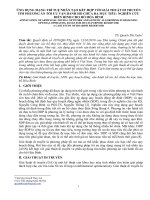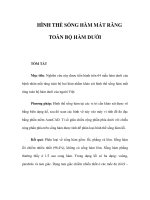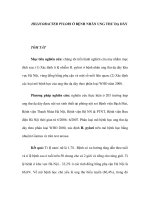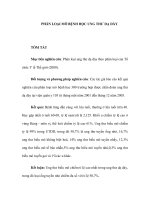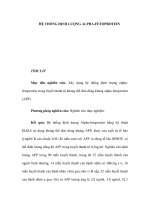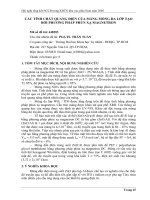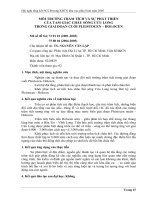Mối quan hệ giữa đa hình gen của interleukin10 và các loại hội chứng Trung Y trong xơ gan sau viêm gan B
Bạn đang xem bản rút gọn của tài liệu. Xem và tải ngay bản đầy đủ của tài liệu tại đây (488.46 KB, 6 trang )
Hindawi Publishing Corporation
Evidence-Based Complementary and Alternative Medicine
Volume 2012, Article ID 298925, 6 pages
doi:10.1155/2012/298925
Research Article
Interleukin-10 Genotype Correlated to Deficiency Syndrome in
Hepatitis B Cirrhosis
Qing-Ya Li,1, 2 Zhi-Zhong Guo,1, 2 Jian Liang,3 Wei Zhang,4 Lie-Ming Xu,5 Yue-Qiu Gao,5
Xiao-Su Wang,6 Dong-Ying Xue,7 and Shi-Bing Su1
1 Research
Center for TCM Complexity System, Shanghai University of TCM, Shanghai 201203, China
University of TCM, Zhengzhou, Henan 450008, China
3 Ruikang Hospital of Guangxi University of TCM, Nanning, Guangxi 530011, China
4 Longhua Hospital, Shanghai 200126, China
5 Shuguang Hospital, Shanghai 200021, China
6 Yueyang Hospital, Shanghai 200437, China
7 Putuo Hospital, Shanghai 200060, China
2 Henan
Correspondence should be addressed to Shi-Bing Su,
Received 13 February 2012; Accepted 28 March 2012
Academic Editor: Shao Li
Copyright © 2012 Qing-Ya Li et al. This is an open access article distributed under the Creative Commons Attribution License,
which permits unrestricted use, distribution, and reproduction in any medium, provided the original work is properly cited.
Traditional Chinese medicine (TCM) syndrome is an important basis for TCM diagnosis and treatment. As Child-Pugh
classification as well as compensation and decompensation phase in liver cirrhosis, it is also an underlying clinical classification. In
this paper, we investigated the correlation between single nucleotide polymorphisms (SNPs) of Interleukin-10 (IL-10) and TCM
syndromes in patients with hepatitis B cirrhosis (HBC). Samples were obtained from 343 HBC patients in China. Three SNPs of IL10 (−592A/C, −819C/T, and −1082A/G) were detected with polymerase chain-reaction-ligase detection reaction (PCR-LDR). The
result showed the SNP-819C/T was significantly correlated with Deficiency syndrome (P = 0.031), but none of the 3 loci showed
correlation either with Child-Pugh classification and phase in HBC patients. The logistic regression analysis showed that the
Excess syndrome was associated with dizzy and spider nevus, and the Deficiency syndrome was associated with dry eyes, aversion
to cold, IL-10-819C/T loci, and IL-10-1082A/G loci. The odds ratio (OR) value at IL-10-819C/T was 4.022. The research results
suggested that IL-10-819C/T locus (TC plus CC genotype) is probably a risk factor in the occurrence of Deficiency syndrome in
HBC patients.
1. Introduction
Hepatitis B virus (HBV) infection is a major health problem
in China. It is one of the major causes of virus-related
liver diseases such as liver cirrhosis (LC) and hepatocellular
carcinoma (HCC) [1, 2]. There are 350 million HBV-infected
people around the world, about 15–25% of who have the risk
of dying of the HBV-caused LC and HCC [3]. During the
course of HBV infection, liver is gradually damaged by this
hepatotropic DNA virus, presenting a wide variety of clinical
manifestations ranging from an asymptomatic carrier state
to chronic hepatitis B (CHB), and to HBC, even to HCC
[2, 4]. Five-year survival rate of patients with severe CHB and
HBC is about 50% [5–7]. Whether chronic HBV infection
would be developed to CHB or even LC, the process is
affected by many factors such as hereditary susceptibility of
patients.
DNA sequence and its variations are reflecting the human
evolutionary process. SNP is a variation occurring when a
single nucleotide in the genome (or other shared sequence)
differs between members of a biological species or paired
chromosomes in an individual [8]. It can help us to
understand the occurrence and development of human
diseases, and the response to drug therapy. Currently, it is
known that at least 93% of human genes could present SNPs
[9], and the SNPs have become the research focus of genetic
susceptibility, and in the process of infectious diseases [10].
The previous studies have shown the correlation between the
2
hereditary susceptibility of gene and liver disease, such as
SNPs of aldehyde dehydrogenase 2 (ALDH2) and HCC [11],
interleukin-2 (IL-2), IFN-γ, IL-10 and the infection of HBV,
HCV, or HBV/HCV coinfection [12]. However, the studies of
the correlation between genetic susceptibility and HBC are
quite few.
The classification of disease is an important basis for the
diagnosis of disease. In the LC, the phenotypes have been
used to the classification, such as Child-Pugh classification,
compensation and decompensation phase, hepatocellular
function, and traditional Chinese medicine (TCM) syndromes. The TCM syndrome, also called ZHENG or TCM
pattern, is the basic unit and the key concept in TCM theory.
All diagnostic and therapeutic methods in TCM are based on
the differentiation of ZHENG [13]. ZHENG is an abstraction
of TCM theory, which can be seen as a simply assemblage of
disease symptoms.
In this study, we investigated the correlation between
the IL-10 gene SNPs and phenotypes, which include TCM
syndromes, Child-Pugh classification, and compensation or
decompensation phase in HBC patients.
2. Materials and Methods
2.1. Patients and Samples. In this study, 343 patients
were recruited from Longhua Hospital, Shuguang Hospital,
Yueyang Hospital and Putuo Hospital in Shanghai, the
First Affiliated Hospital of Henan University of TCM and
Ruikang Hospital in Guangxi in China. The patients were
selected based on their age, gender, disease classification
and area distribution (Table 1). All patients were Chinese
yellow race. Blood samples were obtained from all subjects
with informed consent and approved by ethic committee in
respective hospitals, based on the Declaration of Helsinki.
Each subject donated 3 mL peripheral blood samples, which
were collected and stored at −80◦ C before DNA extraction.
2.2. Child-Pugh, Phase, and TCM Syndrome. The patients
were divided into class A, class B, and class C according to
Child-Pugh-Turcotte (CPT) score, and the CPT score was
calculated by rating the following five parameters including
serum levels of bilirubin and albumin, prothrombin time,
ascites, and encephalopathy [14, 15]. According to clinical
symptoms of patients and development of the disease,
liver cirrhosis was divided into compensation phase and
decompensation phase.
The clinical information of HBC patients such as symptoms and signs was collected from the above 6 hospitals,
and then TCM syndromes were classified into Excess,
Deficiency, and Deficiency-Excess syndromes by 3 TCM
senior physicians according to the define of diagnosis, and
TCM syndrome differentiation of liver cirrhosis [16]. The
Excess syndrome was including Liver-qi stagnation syndrome, Damp-heat syndrome, and Blood stasis syndrome.
The Deficiency-Excess syndrome was Damp abundance and
spleen asthenia syndrome. The Deficiency syndromes were
including liver-kidney yin deficiency syndrome and Yang
deficiency of spleen and kidney syndrome.
Evidence-Based Complementary and Alternative Medicine
Table 1: Clinical data of 343 HBC patients.
Gender
Male
Female (%)
Mean age (yr)
Child-Pugh-Turcotte score (%)
A
B
C
Phase (%)
Compensation phase
Decompensation phase
Area (%)
Shanghai
Guangxi
Henan
No (%)
242 (70.55)
101(29.45)
49.57 ± 10.02
240 (69.97)
75 (21.87)
28 (8.16)
203 (59.18)
140 (40.82)
226 (65.89)
69 (20.12)
48 (13.99)
2.3. DNA Extraction. Blood samples of all the patients were
collected in K2 EDTA tubes. Genomic DNA was selected
from 1 mL peripheral blood of each sample, using the
TIANamp Blood DNA Kit (Tiangen Biotech, Beijing, China).
Subsequently, the DNA was stored at −80◦ C for following
genotype analysis.
2.4. SNP Genotyping. Firstly, the genomic DNA extracted
from clinical samples was subjected to a multiplex PCR
(Invitrogen, Carlsbad, CA). Briefly, 1 μL of genomic DNA
was added to a 15 uL final volume containing 0.25 μL per
primer (10 μmol/L) (prime sequence in Table 2), 0.2 μL Taq
enzyme, 1.5 μL 10 × PCR buffer, 0.3 μL dNTPs (2.5 mmol/L),
1.5 uL Mgcl2 and 10 uL deionized water. The reaction
mixture was followed by a denaturation step at 94◦ C for
2 min and 35 cycles of amplification (94◦ C for 20 s, 60◦ C for
20 s, and 72◦ C for 40 s) with a final extension step at 72◦ C for
3 min through ABI 9600 (Applied Biosystems).
Secondly, LDR assays were carried out using conditions
similar to those described elsewhere with slight modifications [17]. Briefly, the final volume containing 2 uL PCR
products, 1 uL 10 × Taq DNA ligase buffer, 0.125 uL Taq
DNA ligase (40 U/uL, New England Biolabs, Beverly, MA)
and 0.01 μL per probe (10 bp) and 6.845 μL deionized water.
LDR probes were designed by the Generay Biotechnology
Company (probes sequence in Table 3). LDR mixtures were
thermally cycled for 20 cycles of 30 s at 94◦ C and 3 min at
64◦ C through ABI 9600 (Applied Biosystems).
Lastly, the mixture of 1 μL LDR product and 2 μL loading
Dye was followed by a denaturation step at 95◦ C for 3 min
and was immediately put into ice-water. Then, the products
were detected by ABI 3730XL DNA sequencer (Applied
Biosystems).
Additionally, about 5% of the samples were randomly
selected and retested by direct DNA sequencing in Shanghai
National Biochip Research Center Laboratory, and the results
were concordant with PCR-LDR.
Evidence-Based Complementary and Alternative Medicine
3
Table 2: The gene position, polymorphism, primer sequences, and gene frequencies of IL-10 SNPs.
Gene position
Rs number
Polymorphism
IL-10-592 A/C
rs1800872
A/C
IL-10-819 C/T
rs1800871
C/T
IL-10-1082 A/G
rs1800896
A/G
Primer sequence
F: AAGAGGTGGAAACATGTGCC
R: TACCCAAGACTTCTCCTTGC
F: ATGGTGTACAGTAGGGTGAG
R: TTTCCACCTCTTCAGCTGTC
F: AGAAGTCCTGATGTCACTGC
R: AAGTCAGGATTCCATGGAGG
Gene frequencies (%)
22.20
57.70
15.10
Table 3: The LDR probes for IL-10 detection.
Gene position
IL-10-592 A/C
IL-10-819 C/T
IL-10-1082 A/G
Probes sequence
A60-S7-TA: TTTTTTTTAACACATCCTGTGACCCCGCGTGTA
A60-S7-TC: TTTTTTTTTTTAACACATCCTGTGACCCCGCGTGTC
A60-S7-TR: -P-CTGTAGGAAGCCAGTCTCTGGAAAGTTTTTT-FAMA60-S6-TC: TGTACCCTTGTACAGGTGAAGTAAC
A60-S6-TT: TTTTGTACCCTTGTACAGGTGAAGTAAT
A60-S6-TR: -P-ATCTCTGTGCCTCAGTTTGCTCACT-FAMA60-S5-TA: AACACTACTAAGGCTTCTTTCGGAA
A60-S5-TG: TTTAACACTACTAAGGCTTCTTTCGGAG
A60-S5-TR: -P-GGGGAAGTAGGGATAGGTAAGAGGA-FAM-
2.5. Statistical Analysis. The data determined by the frequency of genotype obeyed the Hardy-Weinberg equilibrium
(HWE) between the observed and expected genotype values.
The correlation between genotypes and phenotypes was
compared by the X 2 test. P < 0.05 was considered statistically
significant in all tests. A binary logistic regression analysis
was used for the evaluation of the independent effect of IL-10
SNPs on the TCM symptoms of HBC. Odds ratio (OR) and
95% confidence interval (CI) were rated.
3. Results
3.1. Characteristics of the Study Population. The frequencies
of 3 SNPs loci of IL-10 were assessed in 343 HBC patients
in China. The Hardy-Weinberg equilibrium (HWE) test
showed that the distribution of these tested genotypes was
not significantly different from the expected distribution
(P > 0.05) (Table 1). The ages of patients ranged from 18
to 65 years old (mean ± SD, 49.57 ± 10.02). There were no
significant differences of age and sex in gene polymorphisms
in research object (P > 0.05). Males were 242 (70.55%)
and females were 101 (29.45%). In Child-Pugh classification,
class A, class B, and class C were 240 (69.97%), 75 (21.87%),
and 28 (8.16%), respectively. There were 203 (59.18%) in
compensation phase and 140 (40.82%) in decompensation
phase.
3.2. Correlation between IL-10 Genotypes and Child-Pugh
Classification and Compensation or Decompensation Phase
in HBC Patients. As shown in Table 4, there was no significant correlation between IL-10 genotypes and ChildPugh classification in HBC patients. It showed that the
P value was greater than 0.05 between IL-10 genotypes
(−592A/C, −819C/T, and −1082A/G) and class A, class B
and class C of Child-Pugh classification, respectively. Also,
there was no significant correlation between IL-10 genotypes
(−592A/C, −819C/T, and −1082A/G) and compensation or
decompensation phase, respectively (P > 0.05).
3.3. Correlation between IL-10 Genotypes and TCM
Syndromes in HBC Patients. The correlation was analyzed
between IL-10 genotypes (−592A/C, −819C/T, and
−1082A/G) and TCM syndromes in HBC patients. As
shown in Table 5, TC plus CC genotype of IL-10-819C/T was
significantly different with TT genotype (P = 0.031) between
Deficiency syndrome and other TCM syndromes. However,
there was no significant correlation between IL-10-592A/C
and −1082A/G genotypes and TCM syndromes (P > 0.05).
It indicated that the patients with TC plus CC genotype of
IL-10-819C/T may be appearance of Deficiency syndrome.
3.4. Correlation between the TCM Syndromes and Clinical
Data and IL-10 SNPs in HBC Patients. To further clarify
the correlation between Excess syndrome or Deficiency
syndrome and clinical data and IL-10 SNPs in HBC patients,
the binary logistic regression analysis was carried out. The
analytic parameters were including age, gender, IL-10 SNPs
loci (−592A/C, −819C/T, and −1082A/G), clinical symptoms and signs (fatigue, poor appetite, abdominal distension,
backache, limp aching knees, dry eyes, dizzy, pruritus, yellow
urine, aversion to cold, loose stools, spider nevus, ascites) and
hepatocellular function parameters (ALT, AST, bilirubin and
albumin, prothrombin time). The results showed that the
Excess syndrome was associated with dizzy and spider nevus
(Table 6), and the Deficiency syndrome was associated with
dry eyes, aversion to cold, IL-10-819C/T, and −1082A/G loci
4
Evidence-Based Complementary and Alternative Medicine
Table 4: Correlation between IL-10 genotypes and Child-Pugh classification or compensation and decompensation phase in HBC patients.
Gene/genotype
Child-Pugh classification
Class B (%)
Class C (%)
Class A (%)
(n = 75)
(n = 28)
(n = 240)
IL-10-592 A/C
AA
AC
CC
IL-10-819C/T
TT
CT
CC
IL-10-1082A/G
AA
AG
GG
∗
P
Phase
Compensation
(n = 203)
Decompensation
(n = 140)
P
104 (43.7)
108 (45.4)
26 (10.9)
35 (46.7)
35 (46.7)
5 (6.7)
13 (46.4)
13 (46.4)
2 (7.1)
0.839
83 (40.9)
95 (46.8)
25 (12.3)
69 (50.0)
61 (44.2)
8 (5.8)
0.072
114 (47.5)
103 (42.9)
23 (9.6)
36 (48.0)
32 (42.7)
7 (9.3)
12 (42.9)
15 (53.6)
1 (3.6)
0.770
90 (44.3)
89 (43.8)
24 (11.8)
72 (51.4)
61 (43.6)
7 (5.0)
0.076
212 (88.3)
27 (11.3)
1 (0.4)
65 (86.7)
10 (13.3)
0 (0)
22 (78.6)
6 (21.4)
0 (0)
182 (89.7)
20 (9.9)
1 (0.5)
177 (88.5)
23 (11.5)
0 (0)
0.710∗
0.340∗
Between AA and AG + GG of IL-10-1082A/G.
Table 5: Correlation between IL-10 genotypes and TCM syndromes in HBC patients.
TCM syndrome type
Excess syndrome
Deficiency-Excess syndrome
Deficiency syndrome
Total
∗X2
AA
197
41
61
299
IL-10-592
AC + CC
29
7
8
44
P
0.999
0.735
0.778
TT
111
27
23
163
IL-10-819
TC + CC
112
24
46
180
P
0.600
0.470
0.031
GG
22
4
7
33
IL-10-1082
AG + AA
203
49
56
308
P
0.969
0.621
0.726
test.
(Table 6). The odds ratio (OR) value at IL-10-819C/T was
4.022. It further indicated that IL-10-819C/T locus (TC plus
CC genotype) is probably a very high risk in the occurrence
of Deficiency syndrome in HBC patients.
4. Discussion
TCM syndrome classification, also defined as ZHENG differentiation, is the basic concept in the TCM theory. TCM
syndrome, a profile of symptoms and signs as a series of
clinical phenotypes, plays an important role in understanding the human homeostasis and guiding the applications
of TCM treatment. All diagnostic and therapeutic methods
in TCM are based on the differentiation of the TCM
pattern, and this concept has been used for thousands of
years in China [18]. The “Heat,” “Cold,” “Excess,” and
“Deficiency” are the four basic syndromes in TCM [19]. In
TCM practice, an experiential diagnosis approach has been
frequently used to classify Excess, Deficiency, and DeficiencyExcess syndrome in HBC patients. In order to replace the
traditional experiential diagnosis, the scientific evidence for
TCM syndrome classification is essential, and it would be
beneficial to understand the classification and essence of the
TCM syndrome.
IL-10 is an important immunoregulatory cytokine
mainly produced by activated T cells, monocytes, B cells,
and thymocytes. As an immune response modulator, IL-10
can both stimulate and suppress the immune response [20].
Several polymorphic sites of IL-10 gene promoter region
have been described, including three biallelic polymorphisms
at positions −1082A/G, −819C/T, and −592A/C from the
transcription start site. The IL-10-819C/T C and T alleles
were completely in linkage disequilibrium with the IL-10592A/C A and C alleles, respectively. The −592A allele was
exclusively associated with the −1082A allele. These result
in three different haplotypes: GCC, ACC, and ATA [21]. It
has been reported that IL-10 gene SNP was associated with
several diseases such as breast cancer [22], cervical cancer
[23], multiple myeloma [24], and gastric carcinoma [25].
Moreover, IL-10 promoter polymorphism was associated
with the progression of HBV infection [26].
Previous studies have shown that TCM syndrome is
associated with gene SNPs. For example, the people with 5HTTLPR SS genotype polymorphism may be the susceptible
population of Excess of liver Yang syndrome [27]. The K
allele of ABCA1 gene may be protective factors of phlegm
syndrome and blood stasis syndrome in coronary heart
disease [28]. The kidney-Yang Deficiency syndrome (KDS)
is closely related with special SNP linkage disequilibrium
in the intragenic level, and genes within the flanks of these
SNPs suggest some essential symptoms of KDS [29]. There
was correlation between liver-qi stagnation syndrome and
gene polymorphism of tryptophan hydroxylase (TPH) and
G-proteinβ3 submit (GNB3) in HBC patients [30]. We have
Evidence-Based Complementary and Alternative Medicine
5
Table 6: Correlation between Excess or Deficiency syndrome and clinical data and IL-10 gene SNPs in HBC patients.
Factors
Excess syndrome
Abdominal distension
Dizzy
Spider nevus
Constant
Deficiency syndrome
Dry eyes
Aversion to cold
IL-10-819C/T
IL-10-1082A/G
Constant
B
SE
Wald
P
OR
0.277
0.658
0.385
0.173
0.148
0.203
0.180
0.199
3.509
10.458
4.594
0.755
0.061
0.001
0.032
0.385
0.448
0.605
1.392
−0.903
−1.163
0.191
0.203
0.442
0.430
0.777
5.518
8.868
9.921
4.415
2.240
0.019
0.003
0.002
0.036
0.134
been investigated some cytokine such as TNF-α, TGF-β1 ,
and IL-10 [31] and further found that IL-10 genotype may
correlate with TCM syndrome in HBC patients [32].
In this study, therefore, to further investigate whether
IL-10 genotypes correlated really to TCM syndromes, more
samples from different area (Shanghai, Henan and Guangxi
in China) were applied, compared to Child-Pugh classification and compensation or decompensation phase. The
results showed that IL-10-819C/T locus was significantly
correlated to Deficiency syndrome (P = 0.031), and IL10 gene loci (−592A/C, −819C/T, and −1082A/G) were
not correlated to either Child-Pugh classification or compensation and decompensation phase in HBC patients. The
binary logistic regression analysis showed that the Deficiency
syndrome was associated with dry eyes, aversion to cold, IL10-819C/T and IL-10-1082A/G locus, and OR value at IL-10819C/T was 4.022. The research results suggested that IL-10819C/T locus (TC plus CC genotype) might correlate with
the risk in the occurrence of Deficiency syndrome in HBC
patients. The study provided a proof for TCM syndrome
classification, which would be helpful to the TCM clinical
diagnosis in HBC patients.
Though our results showed that IL-10 genotype might
correlate with Deficiency syndrome in HBC patients, it is
difficult to understand the relationship between IL-10 SNPs
and TCM syndromes, while TCM syndrome changes following patient’s condition and disease situation. In recent years,
following the implementation of Human Genome Project
and high throughput Genomic strategies, a large number
of human complex diseases associated genetic variants have
been identified through Genome-wide association studies
(GWAS) [33]. To discover genetic base of TCM syndrome
changes as well as other phenotypes of diseases, the GWAS
method might provide important clues in future research.
5. Conclusion
In this study, we identified that IL-10-819C/T locus was
significantly correlated to Deficiency syndrome, and the OR
value was 4.022, and indicated that HBC patients with the CC
95%CI
Lower
Upper
1.319
1.931
1.469
1.189
0.987
1.296
1.033
1.763
2.876
2.089
1.566
1.830
4.022
0.406
0.313
1.077
1.230
1.692
0.175
2.276
2.725
9.563
0.941
genotype plus TC genotype at IL-10-819C/T might correlate
with the risk in the occurrence of Deficiency syndrome.
Acknowledgments
This paper was supported by National Science and Technology Major Project of China (no. 2012ZX10005001-004),
National Natural Science Funds (no. 81073134), Leading
Academic Discipline Project of Shanghai Municipal Education Commission (no. J50301), and E-institutes of Shanghai
Municipal Education Commission (no. E 03008).
References
[1] X. Zhang, H. Zhang, and L. Ye, “Effects of hepatitis B virus
X protein on the development of liver cancer,” Journal of
Laboratory and Clinical Medicine, vol. 147, no. 2, pp. 58–66,
2006.
[2] B. J. McMahon, “Epidemiology and natural history of hepatitis
B,” Seminars in Liver Disease, vol. 25, supplement 1, pp. 3–8,
2005.
[3] H. S. Margolis, M. J. Alter, and S. C. Hadler, “Hepatitis B:
evolving epidemiology and implications for control,” Seminars
in Liver Disease, vol. 11, no. 2, pp. 84–92, 1991.
[4] W. M. Lee, “Hepatitis B virus infection,” The New England
Journal of Medicine, vol. 337, no. 24, pp. 1733–1745, 1997.
[5] J. I. Weissberg, L. L. Andres, C. I. Smith, S. Weick, J. E. Nichols,
and G. Garcia, “Survival in chronic hepatitis B. An analysis of
379 patients,” Annals of Internal Medicine, vol. 101, no. 5, pp.
613–616, 1984.
[6] Y. F. Liaw, D. I. Tai, C. M. Chu, and T. J. Chen, “The development of cirrhosis in patients with chronic type B hepatitis: a prospective study,” Hepatology, vol. 8, no. 3, pp. 493–
496, 1988.
[7] F. E. de Jongh, H. L. A. Janssen, R. A. de Man, W. C. J. Hop, S.
W. Schalm, and M. van Blankenstein, “Survival and prognostic
indicators in hepatitis B surface antigen-positive cirrhosis of
the liver,” Gastroenterology, vol. 103, no. 5, pp. 1630–1635,
1992.
[8] nucleotide polymorphism.
6
[9] R. Sachidanandam, D. Weissman, S. C. Schmidt et al., “A map
of human genome sequence variation containing 1.42 million
single nucleotide polymorphisms,” Nature, vol. 409, no. 6822,
pp. 928–933, 2001.
[10] M. Helminen, N. Lahdenpohja, and M. Hurme, “Polymorphism of the interleukin-10 gene is associated with susceptibility to Epstein-Barr virus infection,” Journal of Infectious
Diseases, vol. 180, no. 2, pp. 496–499, 1999.
[11] M. Munaka, K. Kohshi, T. Kawamoto et al., “Genetic polymorphisms of tobacco- and alcohol-related metabolizing enzymes
and the risk of hepatocellular carcinoma,” Journal of Cancer
Research and Clinical Oncology, vol. 129, no. 6, pp. 355–360,
2003.
[12] Q. J. Gao, D. W. Liu, S. Y. Zhang et al., “Polymorphisms of
some cytokines and chronic hepatitis B and C virus infection,”
World Journal of Gastroenterology, vol. 15, no. 44, pp. 5610–
5619, 2009.
[13] S. Li, Z. Q. Zhang, L. J. Wu, X. G. Zhang, Y. D. Li,
and Y. Y. Wang, “Understanding ZHENG in traditional
Chinese medicine in the context of neuro-endocrine-immune
network,” IET Systems Biology, vol. 1, no. 1, pp. 51–60, 2007.
[14] E. Cholongitas, G. V. Papatheodoridis, M. Vangeli, N. Terreni,
D. Patch, and A. K. Burroughs, “Systematic review: the model
for end-stage liver disease—should it replace Child-Pugh’s
classification for assessing prognosis in cirrhosis?” Alimentary
Pharmacology and Therapeutics, vol. 22, no. 11-12, pp. 1079–
1089, 2005.
[15] E. Christensen, “Prognostic models including the Child-Pugh,
MELD and Mayo risk scores—where are we and where should
we go?” Journal of Hepatology, vol. 41, no. 2, pp. 344–350,
2004.
[16] Y. X. Zhang, “Dlagnosis, syndrome differentiation of TCM
and evaluate the curative effect of liver cirrhosis (tentative
scheme),” Chinese Journal of Integrative Medicine, vol. 14, pp.
237–238, 1994.
[17] Z. Xiao, J. Xiao, Y. Jiang et al., “A novel method based on ligase
detection reaction for low abundant YIDD mutants detection
in hepatitis B virus,” Hepatology Research, vol. 34, no. 3, pp.
150–155, 2006.
[18] C. Keji and X. Hao, “The integration of traditional Chinese
medicine and Western medicine,” European Review, vol. 11,
no. 2, pp. 225–235, 2003.
[19] W. Y. Jiang, “Therapeutic wisdom in traditional Chinese
medicine: a perspective from modern science,” Trends in
Pharmacological Sciences, vol. 26, no. 11, pp. 558–563, 2005.
[20] S. Mocellin, F. M. Marincola, and H. A. Young, “Interleukin10 and the immune response against cancer: a counterpoint,”
Journal of Leukocyte Biology, vol. 78, no. 5, pp. 1043–1051,
2005.
[21] J. Eskdale, V. Keijsers, T. Huizinga, and G. Gallagher, “Microsatellite alleles and single nucleotide polymorphisms (SNP)
combine to form four major haplotype families at the human
interleukin-10 (IL-10) locus,” Genes and Immunity, vol. 1, no.
2, pp. 151–155, 1999.
[22] F. Kong, J. Liu, Y. Liu, B. Song, H. Wang, and W. Liu, “Association of interleukin-10 gene polymorphisms with breast cancer
in a Chinese population,” Journal of Experimental and Clinical
Cancer Research, vol. 29, no. 1, p. 72, 2010.
[23] G. A. Stanczuk, E. N. Sibanda, C. Perrey et al., “Cancer
of the uterine cervix may be significantly associated with a
gene polymorphism coding for increased IL-10 production,”
International Journal of Cancer, vol. 94, no. 6, pp. 792–794,
2001.
Evidence-Based Complementary and Alternative Medicine
[24] C. Zheng, D. Huang, L. Liu et al., “Interleukin-10 gene promoter polymorphisms in multiple myeloma,” International
Journal of Cancer, vol. 95, no. 3, pp. 184–188, 2001.
[25] M. S. Wu, S. P. Huang, Y. T. Chang et al., “Tumor necrosis
factor-α and interleukin-10 promoter polymorphisms in
Epstein-Barr virus-associated gastric carcinoma,” Journal of
Infectious Diseases, vol. 185, no. 1, pp. 106–109, 2002.
[26] S. Miyazoe, K. Hamasaki, K. Nakata et al., “Influence of
interleukin-10 gene promoter polymorphisms on disease
progression in patients chronically infected with hepatitis B
virus,” American Journal of Gastroenterology, vol. 97, no. 8, pp.
2086–2092, 2002.
[27] J. S. You, S. Y. Hu, and H. G. Zhang, “Study on emotion mea
surement of liver syndromes in TCM and its correlative study
on polymorphism of serotonin (5 HT) transporter gene,”
Zhongguo Yi Yao Xue Bao, vol. 19, no. 11, pp. 669–671, 2004.
[28] Y. F. Wu, Y. C. Zhou, and X. S. Zhang, “Association between traditional Chinese medicine syndrome of coronary
atherosclerotic heart disease and polymorphism of R219K of
ABCAl gene in Chinese Han male patients,” Zhongguo Zu Zhi
Gong Cheng Yan Jiu Yu Lin Chuang Kang Fu, vol. 10, no. 7, pp.
7–9, 2006.
[29] W. J. Ding, Y. Z. Zeng, W. H. Li et al., “Identification of linkage
disequilibrium SNPs from a Kidney-yang deficiency syndrome
pedigree,” American Journal of Chinese Medicine, vol. 37, no. 3,
pp. 427–438, 2009.
[30] Y. B. Liu, W. Zhang, S. B. Su et al., “Association between liver
cirrhosis of hepatitis B cases with Ganqi depression pattern
and 5HTTLPRVNTRs,TPH A218C,GNB3 C825T polymorphism,” Chinese Journal of Integrated Traditional and Western
Medicine on Liver Diseases, vol. 20, no. 5, pp. 267–271, 2010.
[31] Z. L. Jiang, H. Zhang, S. B. Su, W. Zhang, and Y. B. Liu,
“Relationship between gene polymorphisms of TNF-α, TGFβ1 and IL-10 and posthepatitis B-hepatitic cirrhosis,” World
Chinese Journal of Digestology, vol. 17, no. 31, pp. 3263–3268,
2009.
[32] Z. L. Jiang, W. Zhang, H. Zhang, Y. B. Liu, Q. Y. Li, and S. B. Su,
“Relationship between gene polymorphisms of interleukin-10
and syndrome types of traditional Chinese medicine in post
hepatitis B cirrhosis,” Zhong Xi Yi Jie He Xue Bao, vol. 11, no.
7, pp. 1052–1056, 2009.
[33] J. Hardy and A. Singleton, “Genome-wide association studies
and human disease,” The New England Journal of Medicine, vol.
360, no. 17, pp. 1759–1768, 2009.
